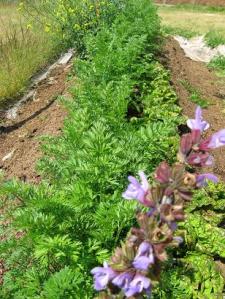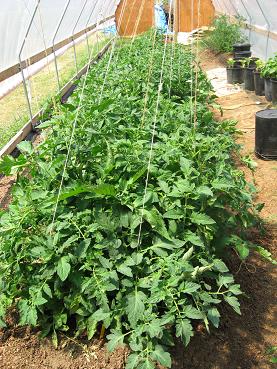We’ve gotten months of tasty greens from our lettuce patch, more than we could have hoped for. The time has come, though, when their biology has caught up with them, and they are reaching for the sky:
Bolting happens – we’re cool with it. About half of the lettuce has bolted or is about to, so we pulled most of it and added it to the donations for the food bank. Along with a huge bag of swiss chard, loads of broccoli leaves, baby Bull’s Blood Beet greens, carrots, and peas, we brought 28 pounds of produce to Good Cheer this week. More pics of the harvest:
Some tasty young chard ripe for the taking
This guy isn’t ready yet, but he’s well on the way in these zucchini days of summer
Artsy sage-and-carrots shot – we thinned the carrots for the last time this week and now they’re growing away to their full size
Our total donation
And now a look inside the greenhouse. The tomatos are growing bushily – I strung them up two weeks ago to give them some more space:
All of those cords are attached to the ceiling – this is a less extreme form of the stringing technique that Hanna at This Garden is Illegal demonstrated here in her blog. There may very well be some fruits lurking in that mass of foliage already, but these cherry tomatos at the far end of the greenhouse are what i’ve found so far:
One more thing, this about saving seed. We want to teach all aspects of gardening to the kids and community members we work with, and a big part of that process is saving your seed from year to year. If a particular crop grows especially well in your garden, it only makes sense to keep the seeds and plant it again and again. There are bigger issues playing into this as well, probably beyond the scope of this blog, but preserving the genetic diversity of seed crops and the freedom of exchange are crucial concepts being threatened by large companies and their policies (watch the documentary The World According to Monsanto for a wake-up call to the importance of these issues – I highly recommend it). By saving our seeds, we keep everything local and increase our connection with what we grow.
For us, the mizuna was a fantastic crop this year, and also the first to go through a complete cycle – it all bolted by mid-May. We left two of the best-looking plants to flower and produce seeds. To keep them from being mistakenly pulled out and to contain them, we tied them to a large stake as we wait for the seed pods to dry:
Another benefit: the yellow flowers have attracted lots of bees to our garden. Once these seed pods have dried, we’ll collect them, pop out the seeds, and store them for next year.







What a gorgeous garden! This spring I planted my first garden and have a lot to learn yet. Thanks for the inspiration and information. And the link to the video on my blog. Cheers!